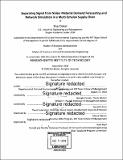Separating signal from noise : material demand forecasting and network simulation in a multi-echelon supply chain
Author(s)
Dekel, Shai, S. M. Massachusetts Institute of Technology
DownloadFull printable version (10.42Mb)
Alternative title
Material demand forecasting and network simulation in a multi-echelon supply chain
Other Contributors
Leaders for Global Operations Program.
Advisor
Georgia Perakis and Saurabh Amin.
Terms of use
Metadata
Show full item recordAbstract
Mismatches between forecasted and actual demand, for construction, repair and maintenance work in a regulated utility, is a growing risk for the performance of the supply chain. High target service levels and high levels of demand uncertainties necessitate Inventory Management to maintain a significant amount of safety stock to buffer against uncertainties. Furthermore, the increasing complex of supply chains make it difficult to anticipate possible effects changes, such as improved forecasting or policy changes. In this thesis we propose an innovative approach for demand forecasting by creating a predictive model based on identifed patterns of repair and maintenance projects underlying the demand data. We further present a unique approach to simulate an overall supply chain, using locally available data, giving the supply chain the ability to evaluate the implications of improved forecasting on the overall network. Through the improved methodology the supply chain can reduce the amount of noise in the data and create a forecast based on data that better represents the real demand. The proposed method improves on current forecasting methods by reducing forecasting noise, such as bullwhip and human error, by tying the forecast for material demand to the forecast of the source of the demand. To do so, we use unsupervised clustering K-means to identify similar consumption behaviors in the data. We further propose the use of a time-series analysis and hierarchical forecast aggregation for the creation of the final forecast, although this will not be the focus of this thesis. Although the results of the clustering process were inconclusive, we present data that supports the validity of out premise and propose alternative algorithms that could produce superior results. In addition we propose a supply chain network simulation to validate the model and valuate its affects. We use the model to emulate the possible effects of forecast improvements on the overall supply chain.
Description
Thesis: S.M., Massachusetts Institute of Technology, Department of Civil and Environmental Engineering, in conjunction with the Leaders for Global Operations Program at MIT, 2018. Thesis: M.B.A., Massachusetts Institute of Technology, Sloan School of Management, in conjunction with the Leaders for Global Operations Program at MIT, 2018. Cataloged from PDF version of thesis. Page 111 blank. Includes bibliographical references (pages 105-110).
Date issued
2018Department
Leaders for Global Operations Program at MIT; Massachusetts Institute of Technology. Department of Civil and Environmental Engineering; Sloan School of ManagementPublisher
Massachusetts Institute of Technology
Keywords
Civil and Environmental Engineering., Sloan School of Management., Leaders for Global Operations Program.